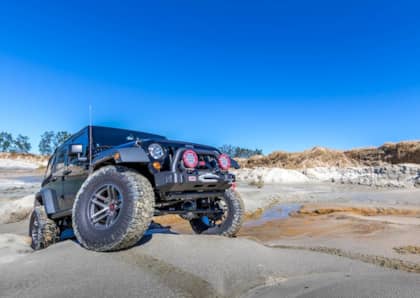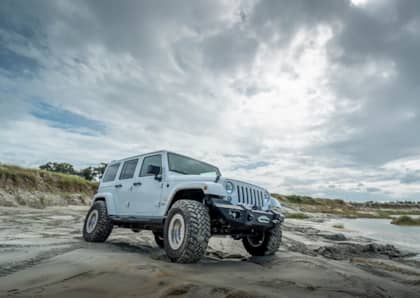Inside Line: The Truth About Coil Spacer Lifts
Since the first Jeep rolled off of the assembly line, people have sought inexpensive ways to lift them. As a general rule, a basic suspension lift will create more ground clearance and allow you to fit on larger tires. Both ideal for anyone who’s looking to spend more time on the trail. As the Jeep platform has evolved, so has the way we lift them.
Starting in 1997, the Jeep Wrangler moved to a multilink suspension configuration that used coils to support the weigh of the vehicle. This is still what is used today and what we see under the Jeep Gladiator. Moving to a coil-sprung suspension opened up room for a new era of inexpensive suspension lifts via the coil spacer. While coil spacers appeared long before the Wrangler platform, the 1997 to 2006 TJ platform made them a commonplace item on the market.
A coil spacer, or budget boost lift as they are often called, uses either a steel or polyurethane spacer to raise the vehicle. These typically sit on top of the vehicle’s existing coil spring and generally go up to 2.5 inches in height. The big draw to these kits is that they are extremely low cost. In fact, many can be picked up for $200 or less. With just about every suspension manufacturer offering some level of spacer-style lift, prices and included components can vary wildly from one company to the next.
In this article, we’re going to break down some of the common misconceptions about the spacer lift and dive into the pros and cons. To provide a little more context, we’ll be showing you the details of the 2.5 Rough Country Suspension spacer lift we installed on a 2017 Jeep Wrangler Unlimited.

Polyurethane Versus Steel
The two most common types of spacers are comprised of either polyurethane or steel. In recent years, we’ve seen a rise in steel spacers on the market. The advantage of the steel spacer is that it won’t break down or collapse in the same way a polyurethane one might. We’ve run both over the years and have not had trouble out of either. We will say however, one of challenges with a steel spacer is that you are at the mercy of the coating. Generally, this isn’t an issue, but it’s something to keep an eye on.

Spacer Popularity
There are a few reasons why spacer lifts have become so popular in recent years. Maybe the biggest is that there are so many OEM spring rates and varied coiled heights. Take the 2018 to present Jeep Wrangler JL for example. Not only does this Jeep have corner-specific coils from the factory, but there are now multiple powertrain options with fluctuating weights. This makes it especially costly and challenging for suspension manufacturers to keep the correct coil springs for all the different configurations on hand. The other reality is that modern Jeeps ride much nicer than older ones. By simply placing a coil spacer atop your existing spring you are essentially preserving that factory ride. Add the aforementioned in with the fact that many of these kits are incredibly inexpensive and it is easy to see why spacer lifts are common place.

What About Shocks?
Since you’re raising the vehicle, the shocks need to be factored into the lift equation. This is why most entry level budget boost kits include shock spacers. These are designed to allow you to reuse your stock shocks by simply spacing out the mounting locations. This helps preserve your factory ride as you are keeping a shock that has been engineered to work with the stock coil spring. What you see next to the stock shock with the Rough Country extension in this photo is a Fox 2.0 Adventure Series shock that was used originally with our JKS Manufacturing 2.5 suspension kit for a different JK.
Given it was the proper length, we went ahead and installed them with the Rough Country spacer lift. Both of these shocks have around 30,000 miles on them, so it was sort of a wash in terms of which was in better shape. We knew however we would get a boost in valving with the Fox shocks, so it was worth going with them. The real takeaway here is that budget boost kits at the lower end of the price spectrum typically do not come with new shocks. We think this is a good thing as your vehicle needs grow, you can always upgrade later.

Tracking Parts
The Jeep Wrangler and Gladiator suspension systems have a fair about of flexibility when it comes to what you can get away with lift-wise before you need a lot of additional parts. On the Jeep Wrangler JK, a track bar relocation bracket is necessary to keep the tracking centered out back. The height of the spacer kit will generally determine what additional components are necessary. The Rough Country kit also included longer rear sway bar links (it calls for reusing the stock rear links up front) as well as brake line extension brackets.

Budget Boost Limits
Since we had previously installed our 35x12.50R17 Nitto Ridge Grapplers with no lift (read all about that here), we already knew what our flex limitations were. Even with the modestly backspaced 17-inch Venom Rex wheels, we would rub the fenders greatly at mild articulation. While the lift gave us more room for our Grapplers to breathe, it did not include bumpstop spacers, which means our tires can potentially still contact the flares. This is why this particular kit is designed more so for those simply looking to raise the Jeep, not necessarily do a lot of serious off-roading.

Leveling
Another popular use of a spacer kit is to raise nose of the vehicle to give it a more level stance. This level look is why many companies will provide a taller front coil spacer. On this Rough Country lift, the front spacer measured 2½ inches, while the rear was only two.

Boosted Decisions
The allure of a dirt-cheap suspension kit has made the spacer kit one of the most common suspension upgrades on the market. Along with the evolution of the modern Jeep platform has come the evolution of the modern spacer lift. These are no longer all just basic budget boost kits. In fact, we are seeing some of these higher-end spacer systems now rival traditional suspension systems from both a cost and included component front.
Ultimately, spacer kits have their place. If you don’t like your current ride quality, a spacer lift usually won’t make a big improvement, unless your issue is more with shock valving. If you are a DIY Jeeper, then you’ll like the fact that these are extremely easy at-home installs. Sure, we would have liked to have seen cam bolts or lower control arms included with our kit. But, for the $200 price, we were happy with what we got.

Click here to see Tested: 35s with no lift on the Jeep Wrangler JK.











